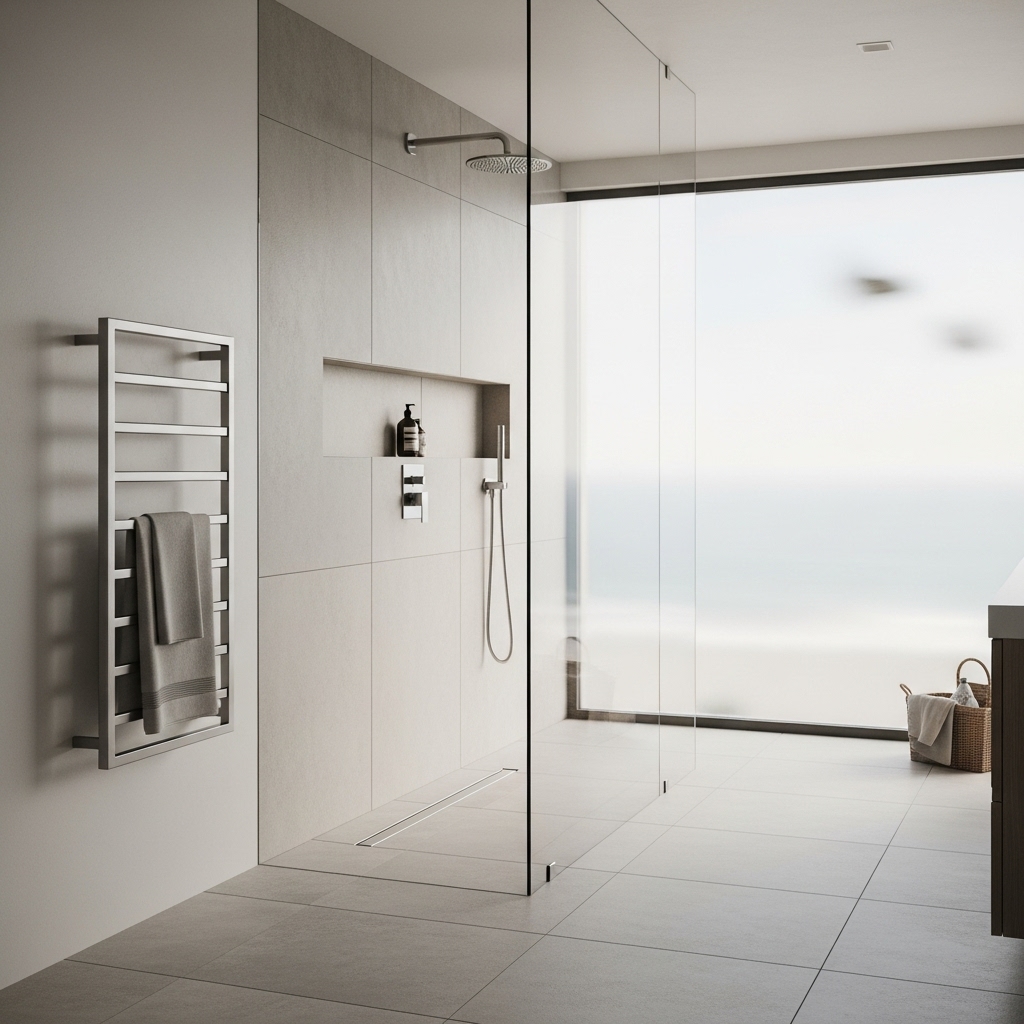Plan a Durable, Spa-Calm Bathroom by the Beach
A great bathroom is equal parts performance and serenity—especially in Huntington Beach, where humidity, salt air, and sandy feet are part of daily life. This checklist and guide will help you plan waterproofing, ventilation, storage, and finishes that stand up to the coast while looking fresh for years. If you want a single team to coordinate design, engineering, permits, and construction, consider the advantages of a design-build approach to your home renovation so every detail supports long-term comfort.
Start by defining how the space should feel and function. Then translate that vision into practical decisions about layout, drainage, and materials. When bath upgrades are designed from the substrate out, you protect your investment and enjoy daily rituals more.
Bathroom Renovation Checklist
- Scope and Layout: Decide if fixtures move or remain. Confirm clearances for doors, shower entries, and turning radii. Plan storage within easy reach of sinks and showers.
- Waterproofing: Select a continuous membrane system with properly treated corners, seams, and penetrations. Verify slope to drain and test pans before tile.
- Ventilation: Choose a quiet, high-capacity fan sized for the room and place it where humidity accumulates. Add timers or humidity sensors for hands-off control.
- Plumbing: Use quality valves, supply lines, and shutoffs. Confirm pressure, temperature control, and access to cleanouts. Consider recirculation strategies for faster warm water if appropriate.
- Electrical and Lighting: Provide GFCI-protected circuits as required. Layer lighting—ambient, task at mirrors, and soft night lighting. Keep color temperatures consistent.
- Surfaces and Finishes: Select slip-resistant flooring and easy-clean wall materials. Plan for expansion joints in large-format tile and appropriate grout.
- Shower Design: Size the shower for comfort, plan niches or ledges for storage, and confirm glass door swing and clearances. Use corrosion-resistant hardware.
- Tub Considerations: If including a tub, ensure structure and access meet manufacturer specs. Plan for splash control and easy cleaning.
- Storage: Integrate medicine cabinets, vanities with drawers, and linen niches. Avoid deep, inaccessible shelves in small spaces.
- Doors and Hardware: Choose finishes that resist corrosion and plan proper clearances for towel bars and hooks.
- Windows and Daylight: Use privacy glazing or treatments and confirm water exposure protection around frames and sills.
- Accessibility and Future-Proofing: Add blocking in walls for future grab bars, choose lever handles, and consider curb-less showers with linear drains.
- Heating and Comfort: Warm floors, towel warmers, and balanced HVAC supply improve comfort and help moisture evaporate.
- Cleaning and Maintenance: Specify sealed edges, quality caulks, and accessible corners. Choose materials that clean easily with gentle products.
- Permitting and Inspections: Prepare drawings, ventilation specs, and any plumbing or electrical updates required for approval.
Coastal Durability: Details that Matter
Salt air accelerates corrosion on metal finishes and fasteners. Choose hardware rated for marine or coastal environments where available, and verify that installers use compatible screws and anchors. In wet areas, prioritize membranes, backer boards rated for moisture, and sealants that maintain flexibility over time. Small details like sealing the underside of stone sills or vanity tops, or wrapping the bottom edges of plywood with protective finishes, can extend service life significantly.
Waterproofing Done Right
Waterproofing is the backbone of a long-lived bathroom. Confirm that substrates are flat and plumb before membranes go in, then test pans and review corner treatments. At niches and benches, use factory corners or pre-formed components where appropriate. Treat every penetration—valves, shower heads, and fasteners—with compatible sealants. A well-built shell allows you to choose beautiful finishes confidently.
Ventilation for Health and Longevity
Humidity control prevents condensation on windows, discourages mold, and protects finishes. Quiet fans encourage daily use; humidity or occupancy sensors make it effortless. Duct runs should be smooth and direct to the exterior. In coastal climates, specify exterior hoods and components designed to resist salt exposure.
Lighting that Flatters and Functions
Layered lighting makes routines easier and more enjoyable. Vanity lights placed to the sides of mirrors reduce shadows, while overhead lights provide general illumination. Night lighting improves safety and keeps the space calm during late hours. Keep color temperatures coordinated throughout for a cohesive look.
Storage that Supports Calm
Design storage around real habits. Medicine cabinets capture grooming items, drawers organize small tools, and shower niches keep bottles off the floor. Incorporate hidden outlets in cabinets for chargers or grooming tools to reduce clutter on counters. Thoughtful organization is a budget-friendly way to elevate daily life.
Shower and Tub Planning
Size showers for comfortable movement and include a place to rest a foot for shaving. If glass is used, confirm panel sizes and hinge swing early. For tubs, confirm that the floor structure supports filled weight and that faucets and hand showers are accessible. In both cases, plan splash control with door sweeps, thresholds, or returns as appropriate.
Flooring and Slopes
Slip-resistant surfaces are essential in wet spaces. For curbless showers, plan careful transitions and slopes that keep water headed to the drain without creating a toe-stubber at the bath floor. In small baths, larger tiles can still work when layouts are carefully planned and substrates are flat.
Electrical Safety and Comfort
Provide protected circuits where required and ensure fixtures near water meet appropriate ratings. Heated floors add comfort and aid drying after showers. If you include mirrors with integrated lighting or defoggers, plan wiring routes early.
Construction Sequencing for a Clean Turnover
Coordinate demolition, rough-ins, waterproofing, tile, glass, and punch in a clear sequence. Protect finished surfaces once installed and confirm material deliveries align with install dates. A tidy, well-sequenced project reduces stress and produces better results.
Frequently Asked Questions
Q: Do I need to move fixtures to upgrade my bath? A: Not necessarily. In-place upgrades can deliver big improvements, but relocating fixtures can unlock better layouts when planned thoughtfully.
Q: What matters most for a long-lasting bath? A: Waterproofing and ventilation. Build a robust shell first, then layer beautiful finishes on top.
Q: Can I create a spa feel in a small bathroom? A: Yes. Use calm colors, layered lighting, efficient storage, and a few tactile finishes to create a relaxing atmosphere.
Q: How do I handle privacy with daylight? A: Use frosted or textured glass, and plan waterproofing details around window frames to prevent leaks.
Q: Are curbless showers difficult to maintain? A: With proper slopes, quality drains, and consistent cleaning, they are straightforward and offer great accessibility.
Q: What about corrosion at the beach? A: Choose coastal-rated hardware and confirm installers use compatible fasteners and sealants to extend finish life.
Transform Your Bathroom with Confidence
Great bathrooms blend robust construction with calming design. When you are ready to upgrade your Huntington Beach home, partner with a team that brings design, permitting, and construction together for streamlined delivery. Begin planning your coastal-ready retreat by exploring a trusted path to home renovation that supports comfort, durability, and daily ease.

